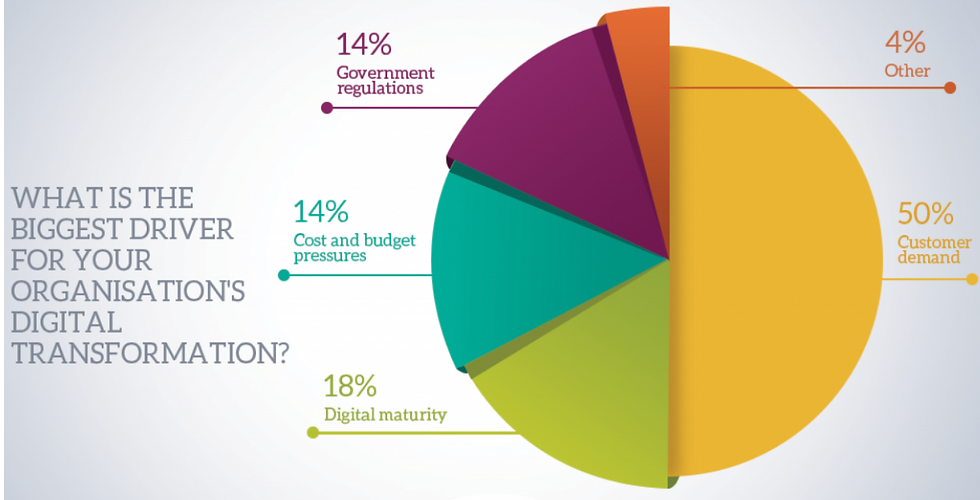Why embark on the Digital Transformation journey?
The first answer that comes to mind when evaluating the investments that need to be made for a digital change is to comply with regulatory requirements. If there’s no obligation, I may as well put it off. However, the infographic shows that the legislative motivation is a smaller percentage than the real incentive: improving Customer Satisfaction.

Another question: Why do I need to make such an expensive investment if my customers are already satisfied? Because, in the long term, innovation not only serves to ensure the renewal of the trust of current customers but also opens up potential scenarios that could generate exponential growth.
Facilities, regulations and funds for the Digital Transformation
But let’s go step by step. A slice of the market also does so for a legal reason. In fact, among funds, benefits and regulations, it can be convenient for a company to invest in digital innovation.
Facilities are especially appealing to large companies, with departments dedicated to research and development, which can relay resources on a hypothetical innovative project. On the other hand, small and medium-sized companies are often forced to digitalize processes or actions to comply with regulatory requirements. One example? Italian government required a transition to e-invoicing in 2019. All companies had to adhere to the change to issuing an invoice within the timeframe established by law. In this case, the law was the determining lever, but later on, companies understood the operational benefits as well.
In the case of digitalization aimed at regulatory compliance, the risk is that the change does not involve the entire firm but only the department or even the individual process involved. This kind of action not only appears inefficient but, in the long run, could even slow down the overall business organization instead of generating improvements.
Budget to invest in innovative projects
The decision to acquire talent and technology to begin a business innovation process can also begin with the pressure of the allocated budget. Suppose that during the annual business planning process, targets were set that directly or indirectly include the costs of investing in technology and innovation. In this case, these costs become a lever in their own right. And even in this case, the problem remains the same: Change Management is difficult to accomplish without strong motivation.
The digital transformation of the market
Today we are amid Digital Transformation, and digital skills are increasingly in demand in the marketplace. To keep our competitiveness high, we need to train our employees and transform our processes and operations before the companies with which we are in direct competition do. In addition to digital literacy, which must involve all company departments, it is also important to hire professionals who know how to give the first guidelines.
The digital change that allows a company to enter the Digital Transformation Era must necessarily involve all business branches. You can’t think of digitalizing just one department by continuing to believe in organizational silos. As previously stated, if you only manage to optimize one process, through innovative software and technologies, after the initial improvements, you will not produce real business efficiency.
Digital Customer Satisfaction
If our direct and indirect customers are digital, then we who generate products and services for them must also be digital. The customer-centric approach, which puts the consumer at the center of all business decision-making processes, is fundamental to increasing customer satisfaction. A satisfied customer is a loyal customer, which is the goal of pursuing par excellence.
How does digital make a difference? First and foremost, data analysis. Knowing the customer journey, i.e., what the customer does and how they approach the product/service we sell, is essential to define the marketing strategy. In addition, to reach potential customers, we need to know the interests, locations, and devices they use to satisfy their needs.
On the other hand, if we look at more complex technologies such as Artificial Intelligence, automation, or the potential of IoT, we realize how many new channels are opening to get in touch with the consumer. From Chatbots to answer frequently asked questions to personalized newsletters, all the way to customer recognition when they enter a physical store.
This is true for both the B2C and B2B markets. In fact, if it is part of the supplier network of a highly digitalized multinational, a small company will have to update to maintain contact with the main customer.
Improving the customer experience by entering the era of Digital Transformation is the objective that most of all will increase company performance and brand awareness. In conclusion, it is good to remember that today digitalizing the company is no longer a choice but the only way to ensure a prosperous future.

Comments